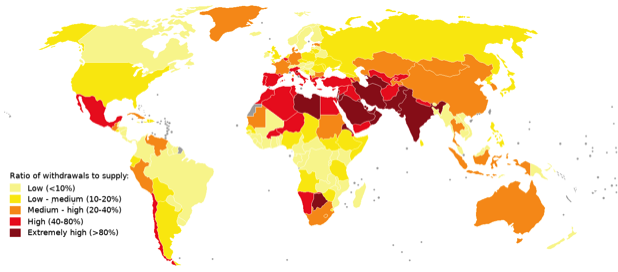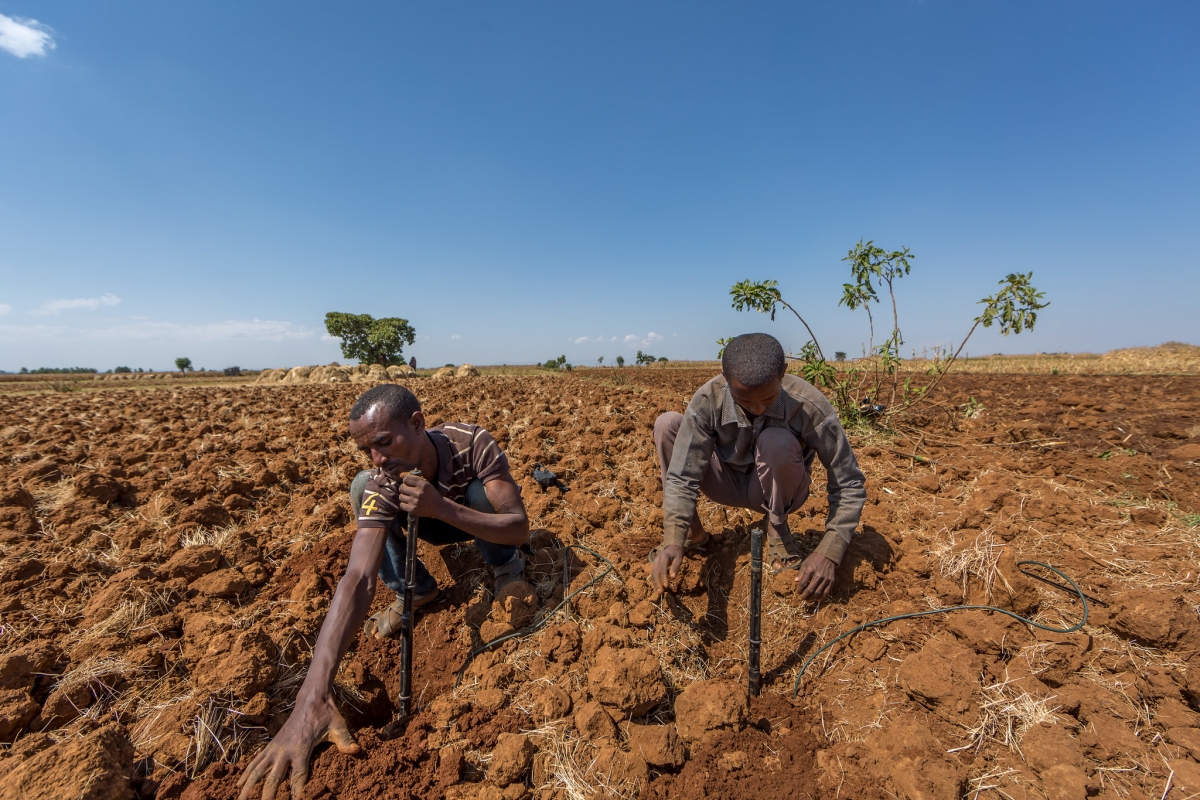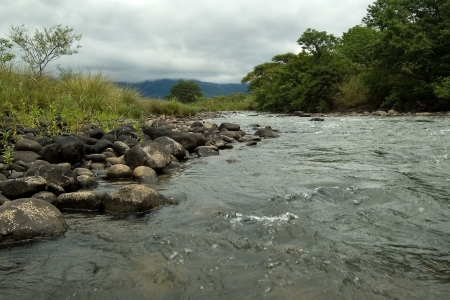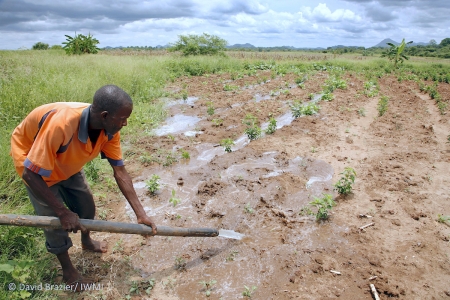Originally published on Rural 21.
The beginning of life on Earth has been linked to water. Modern humans (Homo sapiens) have inhabited this planet for some 300,000 years, most of that time as hunter-gatherers. Some 10,000 years ago, when people increasingly adopted an agrarian way of life, humans started establishing permanent settlements. All of the early civilisations were established close to large water bodies – rivers, lakes and the sea. About 70 per cent of our planet’s surface area as well as of human bodies consists of water. Therefore, water is literally life.
Water underpins nearly everything we do: agriculture, industries, energy production, recreation, drinking, cooking and hygiene. It is also the foundation of every ecosystem on the planet. As such, the management of water cuts across sectors and international boundaries. Furthermore, cities are growing population hot spots and the increasing populations and changing socio-economic expectations will impact water. It also connects themes such as governance, equity, natural resources management, climate change and economic development. This fluidity of water requires equally fluid management systems.
How much water do we have, and can we access it?
The oceans hold about 97.5 per cent of the Earth’s water resources as saline water. Therefore, only 2.5 per cent of all the water on the planet is fresh, making it a relatively limited resource. Furthermore, of this fresh water, around 68.7 per cent is frozen as glaciers and ice caps. And 30.1 per cent is difficult to access as it is stored below the surface as groundwater. This means only 1.2 per cent of all fresh water on the planet is accessible as surface water through lakes, wetlands, rivers, streams, soil moisture or biological water. The hydrological cycle basically consists of flows of water between various stores or storages (e.g. atmosphere, oceans, snow and ice, rivers, lakes, reservoirs, wetlands, soils and aquifers).
Water availability calculations are based on the water resources available per spatial unit (e.g. basin or country) and time (daily, monthly, seasonal, annual or even longer time scales). The mismatch between water availability and demand leads to water scarcity issues and adds stress to societies. There are wide variations in water availability vs. demand between the different regions world-wide (See Figure 1). Water available in a particular country might or might not be generated within its own borders. For instance, upstream countries like Bhutan, Nepal, Ethiopia or China generate basically all their water within their geographical boundaries, while downstream countries like Bangladesh, Egypt, parts of Vietnam or the Netherlands receive the vast majority of their water from across their geographical boundaries.

In certain places, such as uplands in mountainous areas, water availability might be low even though a large river flows just a few hundred metres away in the valley below. If the upland areas have the economic means to access the river water through pumping, they do not have water scarcity issues. Similarly, groundwater or even shallow groundwater might be available, but lacking infrastructure to pump groundwater and necessary capacity, many countries face what is called economic water scarcity. This is especially true in many areas in Africa and South and South-East Asia.
Water and food systems – intrinsically linked
Agriculture is the largest water user, responsible for about 70 per cent of all freshwater withdrawals, most of which is used for irrigation. The 2018 United Nations World Water Development Report forecasts a 60 per cent increase in food demand by 2050, which will require more arable land and intensification of production and will also translate into more use of water. The recent EAT-Lancet report on sustainable diets makes clear that the way we currently produce our food and what we consume is becoming one of our greatest challenges, with the health of people and the environment depending on finding solutions. More than 820 million people have insufficient food, and many more consume an unhealthy diet that contributes to obesity, premature death and diseases. At the same time, global food production severely impacts climate stability and ecosystem integrity and constitutes the single largest driver of environmental degradation, climate change and the stability of the Earth system.
Agricultural systems are dependent both on hydrology and on related institutions, i.e. systems of governance that support sustainable and wise use of land and water. Sustainable, efficient and affordable water management is key to the transformation of the global food and agricultural systems. There is no agriculture without water. Thus sustainable water management is foundational for producing more food with less resources – referred to as sustainable agricultural intensification (SAI). Furthermore, water is a major contributor to the environmental footprint of agricultural practices. Examples include overdraft from rivers and groundwater leading to unsustainable depletion and transportation of pollutants to adjacent water bodies.
How climate change affects water availability
According to estimates by Gosling and Arnell, by 2050, up to three billion people may be living with increased water scarcity because of climate change, which is reconfiguring the water system. The fifth Intergovernmental Panel on Climate Change (IPCC) assessment reports with medium confidence that global surface temperatures in 2016-2035 will be 0.3°C to 0.7°C higher relative to 1986-2005. Towards the end of the 21st century, global surface temperature is projected with high confidence to exceed 1.5°C relative to temperatures in 1800s. Of course various levels of anthropogenic emission scenarios give us different numbers, underscoring the need for action on emissions.
The IPCC warns that although projected changes particularly in precipitation are not uniform globally, extreme precipitation events will become more intense and frequent in many regions. Global warming has been linked to a wide range of water-related risks that also impact indirectly or directly on agricultural production – including animal husbandry and fisheries – and hence on food production and food security:
- intensification of the global water cycle leading to increasingly extreme events such as floods, droughts and tropical storms;
- changing variability in seasonal patterns of rainfall, onset and length of seasons, heat waves and extreme cold spells;
- less snow cover, loss of glacier ice and changes in river runoff impacting water availability;
- sea-level rise leading to salt water intrusion in coastal systems;
- lower water quality because higher temperatures strongly influence increases in organic matter, nitrate and phosphorus levels in river water;
- increased water pollution, because of more frequent extreme events and higher loads of sediments, nutrients, dissolved organic carbon, pathogens, pesticides and salt;
- significant changes in river flow patterns and hence impacts for the habitat of aquatic biota;
- impacts on groundwater availability. For instance, groundwater storage in the Murray-Darling basin declined substantially from 2000 to 2007 in response to a sharp reduction in recharge during the 1996-2010 Millennium Drought in Southern Australia.
As we understand more about the challenges posed by global warming, it has become widely accepted that water is the principal medium through which society feels the climate-related stresses. Smith et al. have identified water as the “teeth and claws” of climate change. But we have an opportunity to flip water from being a challenge into an opportunity. The world’s community of water professionals largely share the view that water is not just a risk but is also the key to climate change adaptation. The world has a chance to align policy and implementation for water and climate change adaptation agendas around water resilience. This close connection between adaptation and water resources management has been increasingly recognised, and some even called the COP 25 – the 2019 United Nations Climate Change Conference – a ‘water COP’ because of the wide-ranging discussions on water-related climate issues.
Integrated approaches that go with the flow
The direct impacts of climate change on water will be effectively “multiplied” via the effects on the other sectors linked together in the water-energy-food-environment-livelihood nexus. Thus it’s clear we need integrated approaches. Improved water management options from farm-level water management to basin level, if done appropriately, will not only reduce current water-related risks and insecurities but also mitigate many of the potential negative impacts of climate change. Increasing the adaptive capacity and simultaneously enhancing water, food and energy security are often among the ‘ripple effects’ of improved water management and increased resilience of society.
To harness the climate adaptation potential of water – and minimise the climate-related risks – we need integrated management systems. Several concepts, such as the Integrated Water Resources Management, the Water-Energy-Food nexus and the Water Security frameworks, have been promoting various integrative and holistic approaches for basin water management. There have also been many initiatives, such as the establishment of river basin authorities, to introduce related processes around the globe that promote integrated river basin management and development. For example in the European Union, Integrated River Basin Management (IRBM) is fostered by two Framework Directives, which were established to realise sustainable, integrated and effective river basin management. The first one is the Water Framework Directive from 2000 with the objective to assess water quality and achieve a good status for all water bodies. Furthermore, the Food Risk Management Directive deals with the assessment and management of flood risks. Despite these examples, the actual management of water in most countries, and especially in the Global South, is still very fragmented and sectoral. This leads to inefficiency, un-sustainability and, under certain conditions, even to conflicts.
A holistic approach to water management is needed
In recent decades, adaptation to climate change impacts has become one key development agenda often also included in national plans and policies. There remains, however, a big gap in translating these global and national policies to local action plans and services. Furthermore, coordination between management and governance systems is a key challenge to ensure that water resource management is done with the purview of balancing benefits across various sectors, stakeholders and future climate risks. Here, it is important for water resources resiliency and adaptation planning to consider the varying levels of climate vulnerability in a basin given existing structural inequities in gender, income level, class, race, ethnicity, etc.
Above all in the Global South, achieving water sustainability faces a wide range of challenges. Often, data and comprehensive analysis of water resources are lacking at basin/country levels, and development planning and management is usually sectoral (‘silo mentality’) and fragmented. In addition, current governance structures and processes do no facilitate reaching a shared vision to develop a basin/country sustainably regarding water. And there is lack of understanding of the direction and magnitude of future changes and risks related to water and all its implications for the environment, society and economy.

Globally, the 17 Sustainable Development Goals with their 169 associated targets are demanding for holistic and integrated development. The shift in focus from merely growing productivity to also considering equity, social justice, environmental health and all other aspects for sustainability has brought development discourses to a crossroads. New targets and indicators are changing the ways success is measured. Integrated water management will play a key role in the implementation of all SDGs because of the interdependencies between many of the goals and targets. Therefore, understanding and managing trade-offs well will be essential.
We are moving into a world where rather than managing water for individual sectors, such as health and sanitation, we must integrate these with other needs such as water for irrigation, hydropower, industry, and ecosystems. This integration must be across multiple users and uses.
Future water resources management and development should ideally include all sectoral demands and achieve various societal objectives in a balanced way, under a wide range of plausible futures (robust) and incorporate adaptive and flexible solutions. And we need to support these solutions through enabling governance structures and policies that allow us to navigate our water resources challenges in turbulent waters. Our survival depends on this.
Thrive blog is a space for independent thought and aims to stimulate discussion among sustainable agriculture researchers and the public. Blogs are facilitated by the CGIAR Research Program on Water, Land and Ecosystems (WLE) but reflect the opinions and information of the authors only and not necessarily those of WLE and its donors or partners. WLE and partners are supported by CGIAR Trust Fund Contributors, including: ACIAR, DFID, DGIS, SDC, Sida and others.















